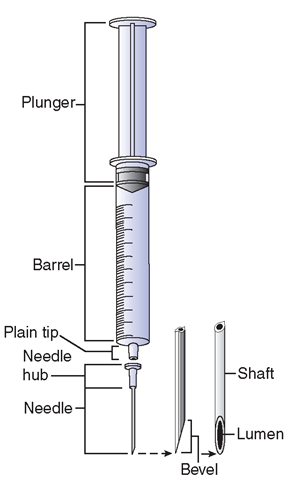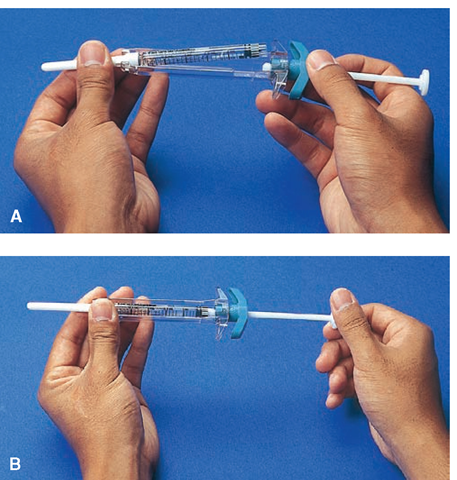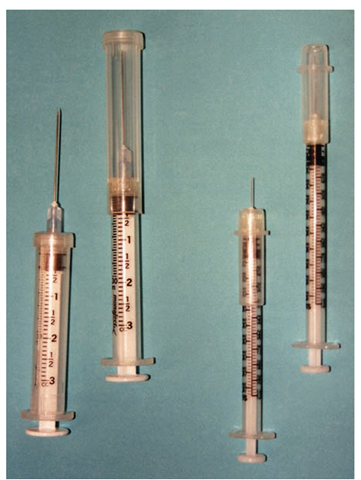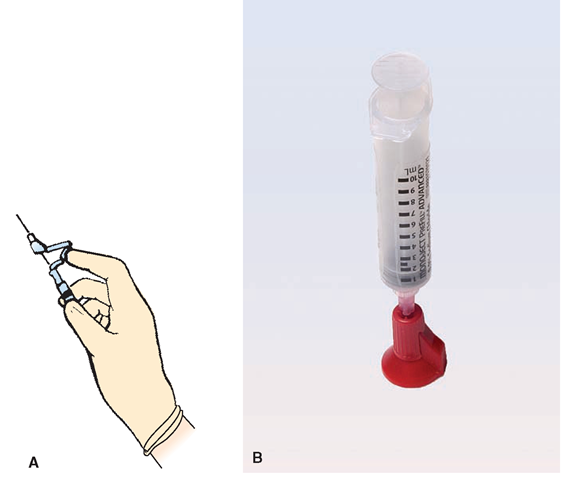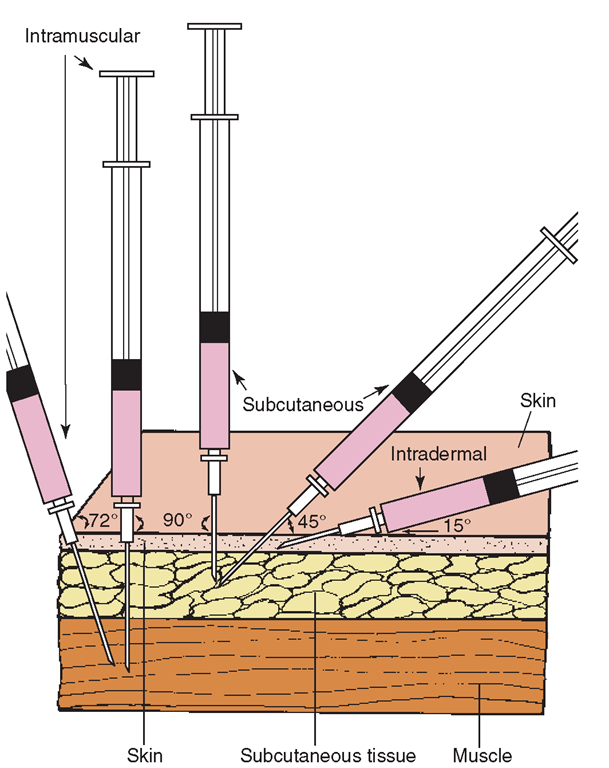Learning Objectives
1. Describe the different types of syringes and the parts of a syringe. State the intended use of each type of syringe.
2. State the hazards of a needlestick injury. Describe how to prevent a needlestick accident with a safety syringe; with a nonsafety syringe.
3. Demonstrate the proper technique for administering intradermal, subcutaneous, and intramuscular injections.
4. Identify how a Z-track injection is administered and when it is used.
5. Identify nursing considerations for the use of total parenteral nutrition.
6. Describe how to flush a saline lock, how to administer medications via the lock, how to discontinue a lock, and how to cap off an existing IV into a lock.
7. Describe how to administer medications by IV piggyback, volume controlled infusion, and existing IV infusion.
8. Demonstrate how to program the IV pump or electronic IV controller used in the local facility.
9. Describe the role of the nurse in assisting with venipuncture; describe the process of venipuncture.
10. State the most common signs of IV infiltration.
11. Describe the role of the nurse in management of IVs, within the legal scope of practice.
12. Describe the process of setting up an intravenous infusion.
|
IMPORTANT TERMINOLOGY |
||
|
ampule |
intramuscular |
transfusion |
|
bolus |
intravenous |
Vacutainer |
|
butterfly needle |
needleless system |
venipuncture |
|
central line |
phlebitis |
vial |
|
diluent |
phlebotomy |
Z-track (zig-zag) |
|
induration |
piggyback infusion |
|
|
infiltration |
saline lock |
|
|
infusion |
subcutaneous |
|
|
intradermal |
tourniquet |
|
|
Acronyms |
|
|
D5/2NS |
KVO |
|
d5ns |
NaCl |
|
d5w |
NS |
|
G |
PCA |
|
ID |
PICC |
|
IM |
SC (SubQ) |
|
IV |
TKO |
|
IVF |
TPN |
|
IVPB |
VAD |
The administration of medications via injection or intravenous (IV) infusion is more invasive than administration by mouth, rectum, or transdermally. This topic introduces the more invasive methods of medication administration by injection. Be aware that regulations vary among the states and provinces as to what procedures are legally performed by a licensed practical nurse or licensed vocational nurse (LPN/LVN). Injection is a method of introducing liquid medications into various body tissues. Common methods of injection include intradermal, subcutaneous (SC [SubQ]), intramuscular (IM), and intravenous (IV). Other methods include intracardiac (within the heart), intramedullary (within the spinal cord), intrathecal (into the subarachnoid space around the spinal cord), intraosseous (within bone), and intraperitoneal (within the peritoneal cavity) (see Table 63-1). Only physicians and specially qualified nurses use these latter routes; for that reason, they are not addressed in this text.
Although the nurse may give injections by various routes, general principles apply for every method. Because any injection is an invasive procedure, sterile equipment is a must to avoid introducing pathogens into the tissues or bloodstream. In addition, the nurse must also be protected against exposure to the client’s blood or body fluids.
A medication may be administered by injection for the following reasons:
• The medication is most effective by injection.
• The medication is unavailable for any other form of administration.
• The client needs the desired action quickly.
• Dosage accuracy is critical; the client must obtain the entire dose.
• The client is nauseated or vomiting and cannot retain oral medications.
• The client’s mental or physical condition renders him or her unable or unwilling to swallow oral medications.
• The digestive system cannot absorb the drug.
In most cases, the body absorbs injected medications much more quickly than it absorbs oral medications. Generally, IV injection achieves the fastest method of systemic absorption.
The nurse must know the locations of common administration sites and the actions of medications to be injected. For example, an accidental injection into a nerve could result in damage and paralysis. Injection directly into a blood vessel could cause the client’s system to absorb the medication too rapidly, with an adverse, perhaps fatal, reaction. Failure to inject certain medications, such as injectable steroids, into deep muscle tissue may cause tissue atrophy, with resultant pitting or deformity of the site. Forgetting to rotate the sites of insulin injections will often cause areas of tissue atrophy and indentation (lipodystrophy).
SYRINGES AND NEEDLES
Syringes
Syringes are available in various sizes, ranging from 0.5 to 100 mL capacity. Syringes consist of three parts: tip, barrel, and plunger (Fig. 64-1). The tip is the portion of the syringe attached to the needle or needleless adaptor. A syringe may have one of two types of tips: a Luer-Lok or plain tip. (Shown in Fig. 64-1 is the plain tip.) The barrel is clearly marked with a calibrated measurement scale. When preparing an injection, draw the medication into the barrel section. The plunger is the inner portion that fits inside the barrel. Pull out the plunger to create a vacuum and withdraw medication; push in to inject medication. Milliliters are subdivided into tenths on the syringe. Read the volume of medication drawn into the syringe at the point where the rubber flange of the plunger is even or parallel with the marked measurement scale on the barrel.
Syringes are disposable. Some come equipped with a needle; others do not and the needle must be attached separately. Other syringes, called cartridges or prefilled syringes, contain premeasured amounts of medication. One type of prefilled syringe is shown in Figure 64-2. This cartridge-type unit is inserted into a reusable holder that contains a plunger.
Needles. Needles are also disposable and consist of three parts: hub, shaft, and beveled tip (see Fig. 64-1). The hub or hilt is the part that attaches to the tip of the syringe.
FIGURE 64-1 · Parts of a syringe (plain tip) and needle.
The shaft is the elongated portion. The bevel (area containing the hole or bore) can vary from regular bevel (long, allowing for easy entry through the skin) to intradermal bevel (blunt, used exclusively for intradermal injections).
FIGURE 64-2 · Using prefilled syringes. (A) The prefilled cartridge is inserted into the holder/injection device. (B) The plunger section is positioned over the cartridge and screwed on to tighten it. This holds the cartridge in place. The cartridge may need to be pushed firmly into place (to break its seal) before injection. The injection is then given as with any syringe. This is not a safety syringe; therefore, the needle must be protected after use (see Fig. 64-4B).
Needles usually are made of stainless steel and come in various sizes. The needle’s gauge and length are both important when choosing the correct type for injection. The gauge (G) is the needle’s inner diameter (bore), through which medication is administered. The gauge is stated using numbers. The larger the number, the smaller the bore. A 25-G needle has a very small opening and would be used for SC or intradermal injections; a 23-G needle, which has a larger bore, may be used for IM injections of more viscous (thicker) liquids; an 18-G needle has a very large bore and may be used for IV injection of large amounts of medication. Insulin syringes are marked differently (100 U/mL) and are not used for anything but insulin.Needles commonly used range in length from /8 to 2 inches. An SC injection is given with a short needle (usually 3/8 inch in length); an IM injection requires a longer needle, with a larger bore, to ensure delivery into the muscle tissue. Although the provider’s order will state the type of injection to give, the needle size to use depends on the medication’s volume (amount) and viscosity. Additionally, some medications, such as steroids, need to be injected deep into muscles and, therefore, will need longer needles for accurate delivery.
Needles and syringes are packaged in sterile wrappers. Be sure to maintain their sterility. Check to make sure that wrappers are intact. Also check expiration dates. If in doubt, obtain a different syringe and/or needle.
Nursing Alert Always dispose of all syringes and needles in the sharps container provided. This helps prevent needlestick injuries to nurses and environmental personnel.
A needlestick injury can cause serious infections and/or other disabilities.
The Safety Syringe
Most syringe-and-needle combinations are some kind of safety syringe. One type has a plastic sheath that is pulled down to protect the needle after drawing up medication and again after administering the medication (Fig. 64-3). The circular type sheath will click into place, but will not lock if pulled straight out. When the nurse is ready to give the injection, the sheath is pushed straight back until it clicks. After giving the injection, the nurse pulls out the sheath and twists it until it clicks. This will lock it into place so it cannot be retracted.
The articulated type sheath is usually found on prefilled syringes or prepackaged needles. In this case, the needle is protected by a sterile needle cover, which is removed when the injection is to be given. After the injection is given, the nurse uses the index finger to push the sheath over the needle (Fig. 64-4A). The sheath clicks into place, protecting the needle. Safety syringes help prevent accidental needle sticks. If a safety syringe is not available, the needle can be injected into a special cap, the Point-Loc device, which locks the tip of the needle in place, to prevent needlestick injuries (Fig. 64-4B). Recapping of needles, even with the “scoop method,” in which the fingers do not touch the needle, is no longer recommended, because of the danger of an accidental needlestick.
FIGURE 64-3 · One type of safety syringe. After drawing up the solution to be injected or drawing blood, the sheath is pulled out and clicked into place, but not locked. This covers the needle while it is transported. The sheath is retracted straight back to administer the injection, and is again pulled out and twisted, to lock it in place, when the injection is completed. This avoids the dangerous practice of recapping needles. Shown are a 3-mL syringe with a 22-G, i /-inch needle (for IM injections) and a 1-mL insulin syringe with a 29-G, /2-inch needle. Each is shown with the sheath retracted and with the sheath in place.
Key Concept If a nurse or environmental worker has a needlestick this must be reported immediately to the employee health service and an incident report filed. The staff member and involved client will require blood tests. If the client has an infection, such as human immunodeficiency virus (HIV) or methicillin-resistant Staphylococcus aureus (MRSA), the healthcare worker may require immediate treatment. Blood tests will be repeated in 6 months, to make sure there is no ensuing infection. Needlestick injuries usually must be reported to the state as well. Because serious health consequences can result from a needlestick injury it is important to take steps to prevent them.
All needles, syringes, ampules, and glass vials are disposed of in the sharps container Rationale: The hazardous waste container does not protect against needle sticks or injury from broken glass. The sharps container is managed using special procedures.
FIGURE 64-4 · (A) Another type of safety syringe has an articulated, levered shield that is pushed over the needle after use. Because it is pushed from above, the fingers do not come in contact with the needle (Timby, 2005). (B) If a safety needle system is not available, the needle must be protected after use. One method is shown here, with the needle pushed into a protective cap (the Point-Loc device) that locks into place, making its removal impossible.
Needleless Systems
Another injection system that prevents needle sticks allows medication to be drawn up into a syringe and injections made into IV tubing without an exposed needle. There are several types of needleless injection systems. They are more commonly used in the hospital setting than in other healthcare facilities. The most commonly used type consists of a rubber-type sheath covering the needle. When the needle is injected into a firm rubber stopper, this sheath is pushed out of the way. When the needle is withdrawn, the sheath moves back into place to cover the needle again. Because it must be pushed into an object with resistance on all sides to push the sheath out of the way, the sheath will not retract when pushed against a finger.
Systems for Various Injection Methods
Subcutaneous injections usually are given using 1- or 2-mL syringes with 58- to 1-inch needles. When injecting more than 1 mL subcutaneously, the dose usually is divided into two syringes and administered in two injections.
Depending on the type and amount of medication, IM injections usually require 2- to 3-mL syringes with 1- to 1/2-inch needles. The angle of injection is also different (72-90 degrees), depending on the type of injection to be given (Fig. 64-5). For an IM injection, 2 to 3 mL is usually the maximum volume that can safely be injected into one site. In some cases, less than that would be considered the maximum. If a greater volume is to be given, two separate injections into different sites must be used.
Intradermal injections typically are given using 1-mL tuberculin syringes. Needles should be 25- to 26-G with a %-inch intradermal bevel (see Fig. 64-3). The intradermal bevel is blunter than a regular bevel and allows easier access to the epidermis. Rationale: Regular-bevel needles are much more difficult to use for intradermal injections because their added length makes accidental entry into the dermis possible. Because the dermis contains blood vessels, the skin would absorb the medication more quickly than desired, which could cause an unwanted systemic reaction.
FIGURE 64-5 · Comparison of the angles of insertion for intramuscular (IM), subcutaneous, and intradermal injections. An IM injection is given at a 72- to 90-degree angle. A subcutaneous injection is usually given at a 45-degree angle, but may be given at up to a 90-degree angle, if a short needle is used or if the person is heavy. The intradermal injection is given holding the syringe nearly parallel to the skin (10- to 15-degree angle).
